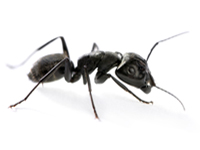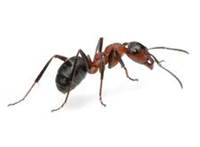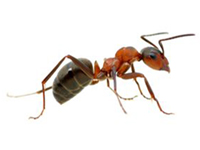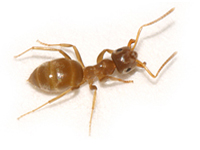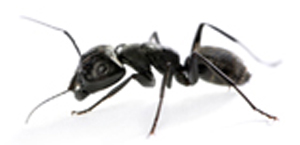
Size:
Large - from 1/4 inch (6.4mm) for a worker up to 3/4 inch (19.1mm) for a queen
Characteristics:
Carpenter ants are Black, or sometimes red and black. They are among the largest ants found in buildings. They live in colonies containing three castes; winged and wingless queens, winged males, and workers. Workers have some brown on them while queens are black. Workers have large heads and a small thorax. Carpenter ants have constricted waists and elbowed antennas.
They are active indoors during many months of the year, usually during the spring and summer. When ants are active in the house during late winter/early spring (March/April), the infestation (nest) is probably within the household. When carpenter ants are first seen in the spring and summer (June/July), then the nest is likely outdoors and the ants are simply coming in for food. The natural food of the ants consists of honey dew from aphids, other insects, and plant juices, but they will readily forage for water and food scraps within the house. Carpenter Ants are among the most common reasons home and business owners on Cape Cod call Fowler and Sons.
Habitat:
Under natural conditions, carpenter ants nest in live and dead trees and in rotting logs and stumps. However, they will also construct their nests in houses, telephone poles, and other man-made wooden structures. Nests are begun in deteriorating wood which has been exposed to moisture. Often, the colony will extend its nest to adjacent, sound wood. Nests are commonly found in porchpillars and roofs, window sills, and wood in contact with soil.
Life Cycle:
The colonies of carpenter ants are often long lived. Each colony is founded by a single fertilized queen. She establishes a nesting site in a cavity in wood.She then rears her first brood of workers, feeding them salivary secretions. She does not leave the nest nor feed herself throughout this period. The workers which are reared first assume the task of gathering food with which to feed the younger larvae. As the food supply becomes more constant, the colony population grows very rapidly. A colony does not reach maturity and become capable of producing young queens and males until it contains 2,000 or more workers. It may take a colony from three to six years or more to reach this stage. Each year thereafter, the colony will continue to produce winged queens and males, which leave their nest and conduct mating flights from May through July.
Damage:
Carpenter ants do not eat wood. They excavate the wood galleries to create nests. Since they do not use wood as a food source they rarely cause structural damage to buildings, although they can cause significant damage over a period of years because nests are so long lived. Some recent evidence indicates that they also cause extensive damage to foam insulation.
Control:
Control of carpenter ant infestations usually requires that the nest be found. Once this is done, the infested wood can be removed or treated, and causes of moisture damage to the wood can be corrected. The best procedure is to inspect all possible locations and to select these locations on the basis of potential water exposure. An insecticide labeled for use outdoors in ant control can be used to create a protective barrier to stop foragers from wandering into the house.
Methods of sanitation and exclusion can be employed to help prevent carpenter ant home invasions or to supplement control of existing infestations. Since carpenter ants require wood and moisture, effort should be made to reduce the availability of these. Stumps, logs and woodpiles should be eliminated or moved as far away from structures as is practical. Openings into the structure -- that is, cracks in the foundation, gaps around doors and windows, and spaces where utility lines penetrate the structure -- should be sealed. Also, correct moisture problems that occur from grades sloping toward the foundation, clogged gutters, leaky plumbing and faulty seals around chimneys, skylights, doors and windows. Overhanging tree branches should be cut back to prevent them from contacting the structure and providing an easy access route for ants.

